Meet the Western Tanager: A Sunset-Colored Songbird
Updated: Feb. 06, 2023
Western tanager flocks migrate through valleys, plains, and foothills. See what the males and females look like and hear their song.
How to Identify Western Tanagers
Birders in the west are in the right area, but they may need luck to spot the flashy feathers of a western tanager. With bright red heads, vibrant yellow bodies, and black wings with prominent wing bars and black tails, males resemble a bright flickering flame. They measure 7-1/4 inches long with a wingspan of 11-1/2 inches. Despite the bold field marks, these birds are hard to find, often hiding in the treetops of western conifer forests.
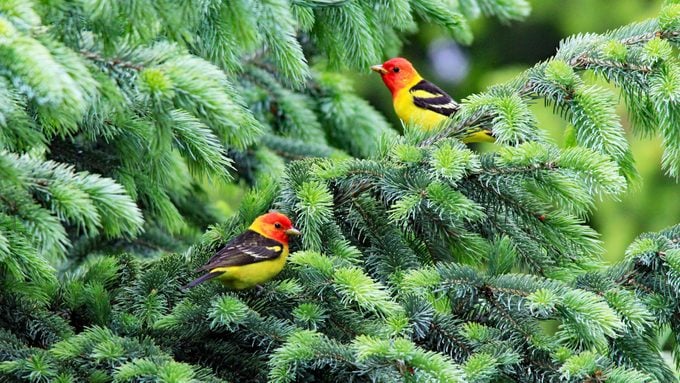
“Western tanagers are more often heard than seen at our place,” says Sally Roth, lifelong naturalist and author who lives amid a dense pine and spruce forest in the high Rockies of northern Colorado. “When I hear one singing, I lift my binoculars to find it,” Sally says. “That color is unmistakable! It sure catches your eye against the green of the trees.”
Check out 11 gorgeous photos of western tanagers.
Female Western Tanager
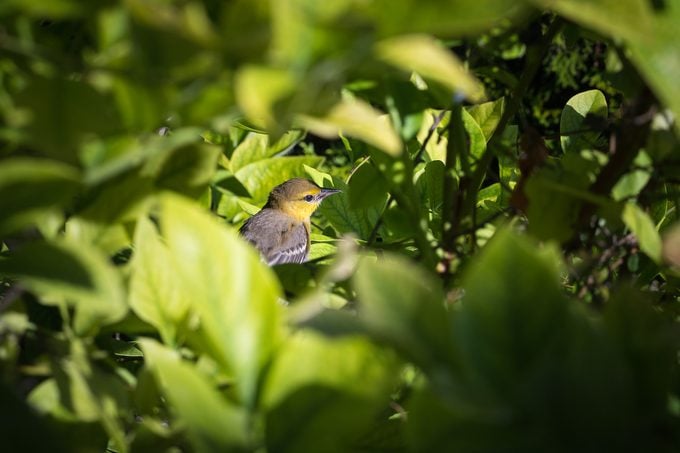
Females and young males are less showy, sporting muted yellow bodies with black wings and a grey back. Check out 4 vibrant tanager species you should know.
What Do Western Tanagers Eat?
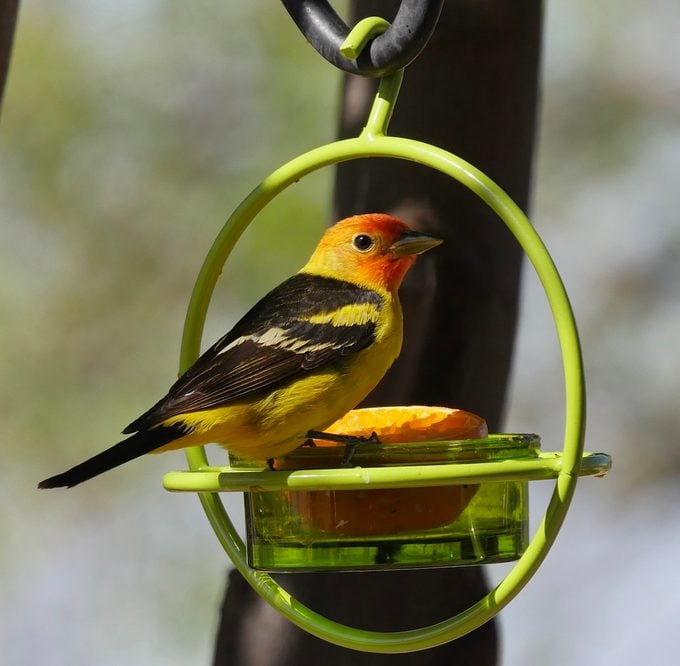
As western tanagers arrive from Mexico and Central America during spring migration, they seek extra fuel in backyard offerings of dried and fresh fruit, especially orange halves. They may also visit sugar water feeders and eat grape jelly. Sally sees one or two western tanagers at her feeders each spring. “But once they claim their nesting territory, they aren’t interested in the feeder—there are too many tasty caterpillars around,” she says.
Like orioles, western tanagers consume mostly insects once breeding season begins. Protein-packed grasshoppers, wasps, ants, termites and beetles are favorites. The birds nab bugs in midair or carefully pluck them from foliage, branches and flowers as they forage through trees and shrubs.
Discover surprising facts about tanagers.
Western Tanager Song
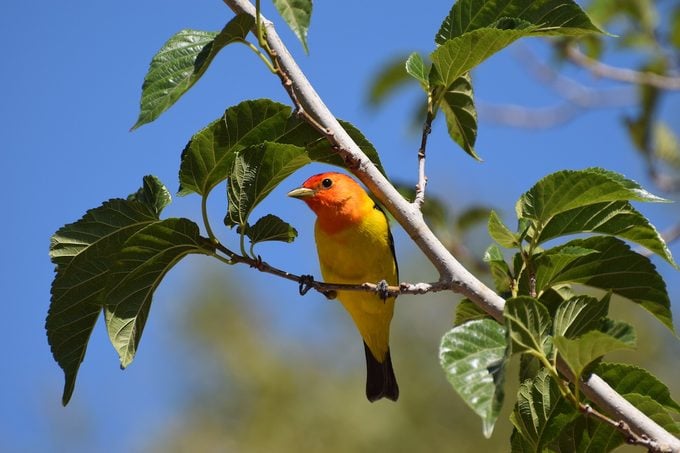
The male is extremely protective over his breeding area. He belts out a robin-like song, full of rising and falling whistles, to stake his claim.
Bird songs provided by the Cornell Lab of Ornithology.
Look up high to spot stunning scarlet tanagers.
Western Tanager Nest and Eggs
A female scouts out a nesting site almost as soon as she arrives at the breeding grounds. She swiftly flies through open tree canopies until she finds a suitable spot to raise a family. Nest-building duties are the female’s job, although the male is never far away. Four or five days after she begins building, the pair has a brand-new twig home that is filled in and lined with materials such as bark, moss, stems, grasses, pine needles and feathers. The female lays three to five bluish-green eggs with irregular brown spots.
Discover how orioles weave elaborate nests.
How to Attract Western Tanagers
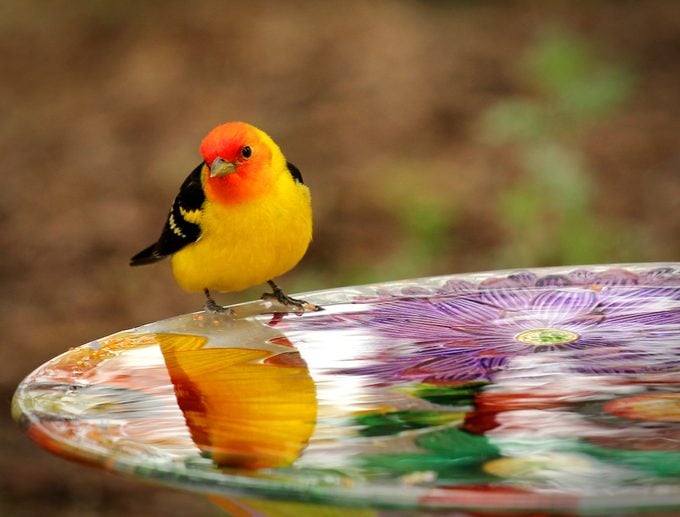
A backyard filled with trees is the best way to encourage western tanagers to call your landscape home or stop by for a quick snack. When they’re passing through during fall migration, berry trees and shrubs like serviceberry, blackberry and elderberry help to fill them up. Bird baths, especially those with moving water, lure western tanagers and many other species throughout summer and during spring and fall migrations.
Summer tanagers may be hiding in plain sight.
Western Tanager Range Map and Habitat
This species breeds as far north as Canada’s Northwest Territories and may spend as little as two months in the brisk locale before heading back to the tropics. Look for them in evergreen forests in summer and in any kinds of woodlands, riversides, or even deserts during migration.
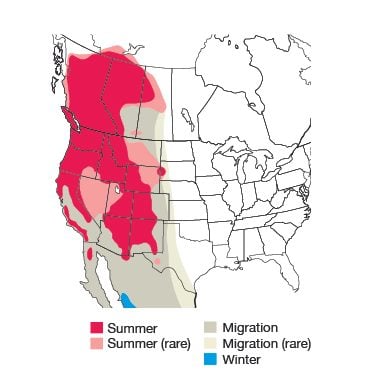
Range maps provided by Kaufman Field Guides, the official field guide of Birds & Blooms.
Western Tanager in Wisconsin
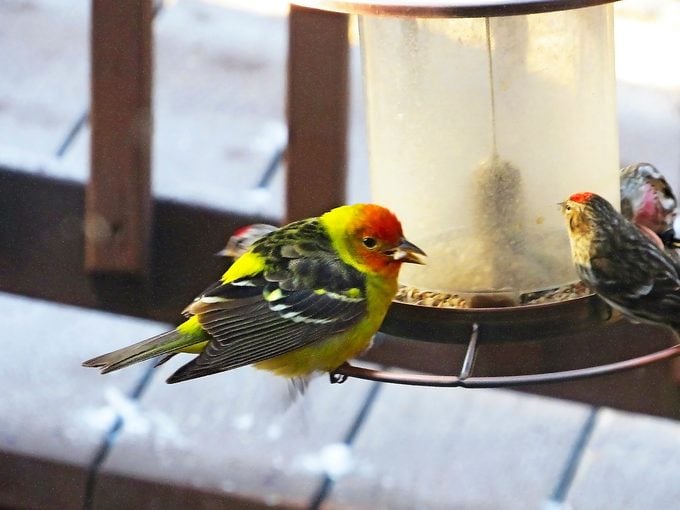
“What’s this bird at my feeder?” —Birds & Blooms reader Carla Kloess
Birding experts Kenn and Kimberly Kaufman write, “That’s a remarkable feeder visitor for Wisconsin: a male western tanager. These colorful songbirds normally live in western Canada and the western U.S. in summer, and in Mexico and Central America in winter. In late March, when you took your photo, they should be just beginning to migrate north. Western tanagers do wander eastward, so there have been a few dozen sightings of this bird in Wisconsin previously, but this is still totally unexpected.”
Next, learn where to find flame-colored and hepatic tanagers.
